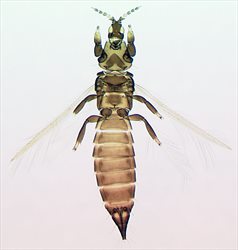
Female
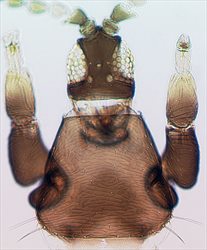
Head, pronotum & fore legs
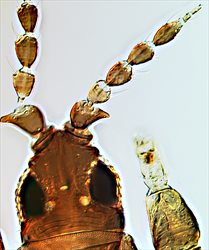
Head & antennae

Antenna

Forked sensorium on antennal segment IV

Female antennal segments I-IV
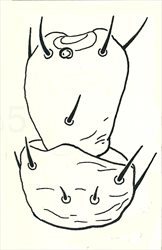
Male antennal segments I-II
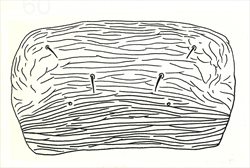
male metanotum
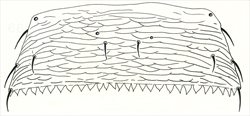
Female tergite II
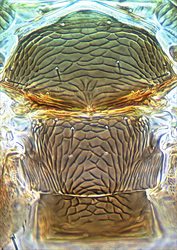
Meso & metanota
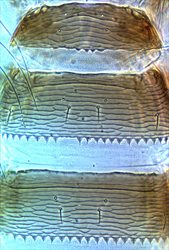
Abdominal tergites I–III
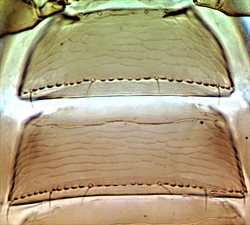
Sternites II-III

Fore wing
Female fully winged. Body, antennae and legs brown, tarsi paler, fore wings light brown. Antennae 8-segmented; segment II asymmetric but without a terminal sensorium; segment III with simple sense cone, IV with forked sense cone. Head small, prolonged in front of eyes with long preocellar area; only 2 pairs of ocellar setae, pair III anterolateral to fore ocellus; maxillary palps 3-segmented. Pronotum trapezoidal, with 2 pairs of prominent posteroangular setae. Metanotum weakly reticulate, median setae small and not arising at anterior margin; meso and metafurca with well-developed lateral flanges. Fore wing pointed; first vein distal half with 2 or 3 setae, second vein with 5 or 6 setae. Abdominal tergites medially with transverse sculpture lines, posterior margin with craspedum of small rounded or pointed lobes; ovipositor moderately developed, with rows of teeth. Posterior margin of sternites with row of small tubercles.
Male micropterous, with minute wing lobe; head with no ocelli; antennal segment IV sense cone simple; sternites III–IV (sometimes also V–VII) with small circular pore plate.
Currently there are 42 species worldwide placed in the genus Chirothrips. In contrast, zur Strassen (1960) treated the genus in a broad sense, with a key to 50 species, whereas Bhatti (1990b) placed several of the species into six new genera. The generic classification was further reviewed by Nakahara & Foottit (2012). From Europe, zur Strassen (2003) recognised 14 species of Chirothrips, of which five have been taken in Britain. C. aculeatus differs from the other British species of Chirothrips in having the posterior margin of the abdominal tergites with a craspedum that consists of well-defined, clearly detached, round or pointed lobes.
Each larva feeds and pupates within a single flower of its host plant (Minaei & Mound, 2010), and these include Poaceae in several genera, such as Avena and Bromus.
Recorded once in Britain, when twenty males were swept from grass at Cirencester, Gloucestershire, in 1931 (Mound et al., 1976), but widespread in the western Palaearctic south east to Iran.
THRIPIDAE - THRIPINAE
Chirothrips aculeatus Bagnall
Pezothrips (?) pedestris Karny, 1910: 55
Chirothrips aculeatus Bagnall, 1927: 567
Chirothrips angusticornis Bagnall, 1932: 186
Chirothrips moultoni Post, 1961: 137
Chirothrips adusta Wetzel, 1963: 635
Bhatti JS (1990b) On some genera related to Chirothrips (Insecta: Terebrantia: Thripidae). Zoology (Journal of Pure and Applied Zoology) 2 (4): 193–200.
Minaei K & Mound LA (2010) Grass-flower thrips of the genus Chirothrips (Thysanoptera: Thripidae), with a key to species from Iran. Zootaxa 2411: 33–43.
Mound LA, Morison GD, Pitkin BR & Palmer JM (1976) Thysanoptera. Handbooks for the Identification of British Insects 1 (11): 1–79.
Nakahara S & Foottit RG (2012) Review of Chirothrips and related genera (Thysanoptera: Thripidae) of the Americas, with descriptions of one new genus and four new species. Zootaxa 3251: 1–29.
zur Strassen R (1960) Key to and catalogue of the known species of Chirothrips Haliday, 1836 (Thysanoptera: Thripidae). Journal of the Entomological Society of South Africa 23 (1): 144–176.
zur Strassen R (2003) Die terebranten Thysanopteren Europas und des Mittelmeer-Gebietes. Die Tierwelt Deutschlands 74: 1–271.